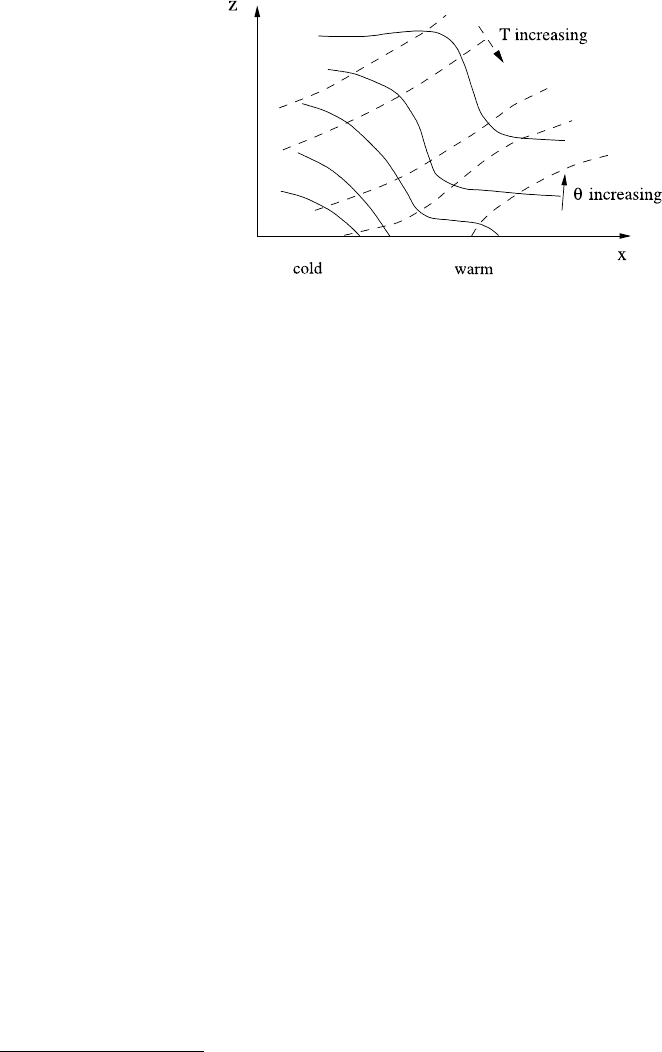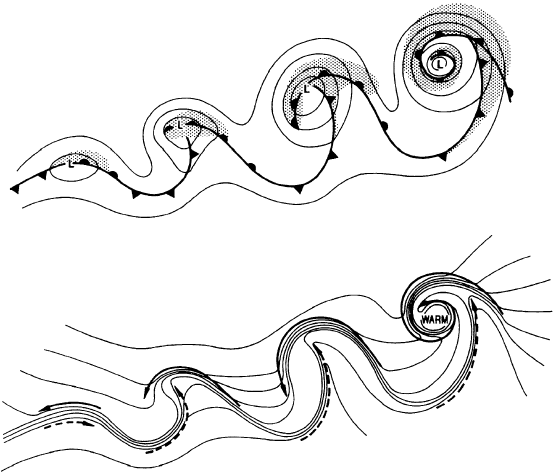Fowler A. Mathematical Geoscience
Подождите немного. Документ загружается.


180 3 Oceans and Atmospheres
Fig. 3.6 Contours of
temperature (dashed lines)
and potential temperature
(solid lines) in a forming front
As the front develops, the baroclinic instability also distorts the flow in a wave-
like pattern. The effect of this is to bend the front round, as illustrated in Fig. 3.7,
forming a series of vortex-like rings. In the atmosphere, these are the cyclonic dis-
turbances which form the mid-latitude low pressure storm systems, with typical
dimensions of 2000 km. They also occur in the ocean, forming coherent rings of
some 50 km diameter.
The description above is a little idealistic. On the Earth, fronts are an intrinsic
consequence of the difference in properties between different air masses. The mid-
latitude cells, for example, are bounded north and south by fronts across which the
wind direction and the temperature changes. The warm mid-latitude westerlies are
bounded polewards by the cold polar easterlies. The situation is complicated by
continents and oceans. Continental air is dry, whereas oceanic air is moist. As a
consequence of these geographic variations there are a number of different types of
air masses, and the boundaries between these provide the seeds for frontal develop-
ment. The fronts move and distort as shown in Fig. 3.7, but it is more sensible to
think of the roll-up of a planar front and the formation of storm systems as a result of
(Kelvin–Helmholtz like) instability of a linear vortex sheet, rather than as a conse-
quence of shock formation in the nonlinear wave evolution of the quasi-geostrophic
potential vorticity (QGPV) equation. In fact, the QGPV equation does not do a very
good job of numerical weather front prediction.
23
3.7.1 Depressions and Hurricanes
The storm systems which develop as shown in Fig. 3.7 are called cyclones. They
are like vortices which rotate anti-clockwise, and are associated with low pressure
at their centres (thus they are also called depressions). Conversely, a high pressure
vortex rotating clockwise is called an anti-cyclone. A severe storm with central pres-
sure of 960 millibars represents a dimensionless amplitude of 0.04 ∼ε
2
, and is thus
within the remit of the quasi-geostrophic scaling.
23
This comment is due to Peter Lynch.

3.7 Frontogenesis 181
Fig. 3.7 Two views of the formation of cyclonic depressions from a baroclinically unstable front.
The illustration resembles the Kármán vortex street which forms at moderate Reynolds number in
the flow past a cylinder. The upper diagram shows isobars, the front, and cloud cover (stippled);
the lower diagram shows isotherms, and flow of cold air (solid arrows)andwarmair(dashed
arrows). From Barry and Chorley (1998), page 162; their image is derived from a figure in Shapiro
and Keyser (1990), and is reproduced with permission of the American Meteorological Society
In the tropics, tropical cyclones occur, and the most severe of these is the hur-
ricane, or typhoon. In essence, the hurricane is very similar to the mid-latitude de-
pression, consisting of an anti-clockwise rotating vortex, with wind convergence at
the surface, and divergence at the tropopause. It is, however, fuelled by convection,
and can be thought of as the result of a strong convective plume interacting with the
Coriolis force, which causes the rotation, and in fact organises it into a spiral wave
structure, as can be seen in satellite images by the spiral cloud formations.
The hurricane is distinguished by its high winds, high rainfall and relatively small
size (hundreds rather than the thousands of kilometres of a mid-latitude cyclone).
The strongest hurricane on record was hurricane Gilbert in 1988, where the central
pressure fell to 888 mbar, and maximum windspeeds were in excess of 55 m s
−1
(200 km hr
−1
). The strong convection is a consequence of evaporation from a warm
ocean, and it is generally thought that hurricane formation requires a sea surface
temperature above 27° centigrade, or 300 K. Relative to a mean surface temperature
of 288 K, this is an amplitude of 12 K, and dimensionlessly 12/288 ≈ 0.04, of
O(ε
2
). In the tropics, the Rossby number ε is higher, and near the equator the quasi-
geostrophic approximation breaks down, but hurricanes do not form in a band near
the equator.
182 3 Oceans and Atmospheres
Hurricanes typically move westwards in the prevailing tropospheric winds, and
dissipate as they move over land, where the fuelling warm oceanic water is not
present, and surface friction is greater. They develop a central eye, which is rela-
tively calm and cloud free, and in which air flow is downwards. In hurricanes, this
eye is warm.
3.8 The Mixed Layer and the Wind-Driven Oceanic Circulation
Much of what we have said concerning the dynamics of the atmosphere applies to
the world’s oceans. The oceans form a thin layer of mean depth (slightly less than)
four kilometres, spread over the globe. The dynamics of the oceans are thus those of
a shallow layer of fluid on a sphere, just as for the atmosphere. There are, however,
some differences. Water is essentially incompressible, though in fact the density
dependence on temperature and salinity causes the oceans to be stably stratified,
just as the atmosphere is. The Brunt–Väisälä frequency is about ten times smaller in
the ocean than in the atmosphere.
More importantly, the ocean is blocked by continents. The atmosphere is blocked
by mountains, but can flow over them; the oceans have to flow round continents.
This causes boundary layer effects in the oceanic circulation which are distinctive.
The other major difference between oceans and atmosphere is in the driving
mechanism for the flow. Differential heating between equator and pole drives the
atmospheric flow, and this also drives the global thermohaline circulation (see
Sect. 3.10) of the ocean, but the atmospheric circulation itself drives a circulation
by means of wind stress at the surface. The global convective circulation due to dif-
ferential heating and the wind-driven circulation interfere with each other, and it is
not even clear which, if either, is dominant in determining the flow. In this sense,
oceanic flow is much less well understood than atmospheric flow.
The vertical structure of the oceans is as follows. Near the surface there is a mixed
layer, of typical thickness of the order of 50–100 metres, in which the density is
uniform. This layer exists by virtue of the atmospheric wind stress, which mixes
the surface waters. Below the mixed layer, the density begins to increase, and there
is a thermocline over which the temperature changes from its warm surface value
to the cooler deep ocean value. The thermocline has a thickness of the order of a
kilometre, and the temperature contrast (warm at the surface, cool at depth) exists
throughout temperate latitudes. It does not exist at the poles, but here the thermal
structure is determined by the presence of sea ice. At the poles, salinity is of greater
importance in determining the density profile. The thermal structure of the oceans is
consistent with the concept of a thermally driven convective flow, which we describe
later. First, we describe the wind-driven circulation.
The principal feature of the near-surface circulation of the oceans is the pres-
ence of circulatory flows with strong western boundary currents. In the North At-
lantic, there is a clockwise circulation, with a strong current running up the Eastern
seaboard of the United States. This Gulf Stream separates and flows across towards
Europe, and is instrumental in providing Northern Europe with its anomalously

3.8 The Mixed Layer and the Wind-Driven Oceanic Circulation 183
warm climate. A similar current (the Kuroshio) occurs in the Western Pacific. These
strong currents are due to the effects of the wind-driven circulation. In order to un-
derstand them, we need to formulate a model for ocean circulation in response to
surface forcing.
Our starting point is with the dimensionless shallow water equations of (3.43)
and (3.44). While the dimensionless variables are defined the same way as for the
atmosphere, the scales are somewhat different. Typical velocities in the ocean are of
order U ∼0.1ms
−1
, a typical ocean horizontal length scale is l ∼ 3,000 km, while
the ocean depth is taken as h ∼ 4 km. Assuming these values, we find δ ∼ 10
−3
,
Σ ∼0.5, Ro ∼0.25×10
−3
and F ∼0.5×10
−3
. We immediately assume that δ and
Ro are negligible. We also assume that sea water is (approximately) incompressible,
so that ∇. u =0, and we suppose that the ocean depth is uniform, of dimensionless
depth one. Our coordinate system assumes that z = 0 defines mean sea level. From
(3.43), we thus have
cosλ
0
cosλ
∂u
∂x
+
1
cosλ
∂(vcos λ)
∂y
+
∂w
∂z
=0. (3.180)
The third component of the momentum equation implies hydrostatic equilibrium,
and in view of the smallness of F
2
/Ro, we write the solution as
p =−z +
F
2
Ro
η(x,y). (3.181)
η represents sea surface elevation, and for F
2
/Ro ∼10
−3
, values of η ∼O(1) cor-
respond to elevations of order four metres. The two horizontal components of the
momentum equations thus take the form
−v sin λ =−
cosλ
0
cosλ
η
x
+f
∗
x
,
u sin λ =−η
y
+f
∗
y
,
(3.182)
and the friction terms are prescribed as in (3.46), (3.36), (3.37) and (3.38), which
yields
f
∗
=E
H
∇
2
u +E
V
∂
2
u
∂z
2
, (3.183)
where ∇
2
denotes the horizontal Laplacian, and
E
H
=
ε
H
2Ωl
2
,E
V
=
ε
V
2Ωh
2
(3.184)
define horizontal and vertical Ekman numbers, respectively. If we take ε
V
∼
10
−2
m
2
s
−1
, ε
H
∼10
2
m
2
s
−1
, then we find E
V
∼0.4 ×10
−5
, E
H
∼0.4 ×10
−7
.
(3.180), (3.182) and (3.183) constitute the system we want to solve, subject to
the conditions of no flow through the surface or base,
w =0atz =0 and z =−1, (3.185)

184 3 Oceans and Atmospheres
and subject to an applied (dimensional) surface wind stress τ
w
, which implies
∂u
∂z
=
hτ
w
ρε
V
U
at z =0. (3.186)
In addition we apply a no-slip condition at the base, thus
u =0 at z =−1. (3.187)
The velocity scale U must be chosen by a suitable balance of the driving bound-
ary condition (3.186). It is in fact not quite obvious how to do this. To do so, we
need to anticipate the nature of the solution.
The Ekman numbers E
H
and E
V
are very small. Therefore they can be neglected
except in boundary layers, and the flow is approximately geostrophic. If we integrate
the mass conservation equation upwards from the bottom, we find that as z →0−,
the vertical velocity w will be non-zero, and of O(1), if we suppose (by choice of
U ) that u, v ∼ O(1) in the bulk flow. Therefore in order that w decrease to zero,
we require a boundary (Ekman) layer near the surface, where the vertical Ekman
viscous term becomes important. Evidently, this layer is of thickness O(E
1/2
V
), and
in order for w to decrease by O(1) in the boundary layer, we need u ∼ v ∼ E
−1/2
V
in the Ekman layer. Hence we must have
∂u
∂z
∼
1
E
V
in the surface Ekman layer, and
this allows us to define the velocity scale. In view of (3.184), this suggests that if τ
0
is a scale for the wind stress, and we define
τ
w
=τ
0
τ, (3.188)
then we should choose
τ
0
=2ρUΩh. (3.189)
The boundary condition (3.186) then becomes
E
V
∂u
∂z
=τ at z =0. (3.190)
We may now proceed to a solution. Away from all boundaries, we have the outer
geostrophic solution u =u
0
(x, y), v =v
0
(x, y), where
−v
0
sin λ =−
cosλ
0
cosλ
η
x
,
u
0
sin λ =−η
y
.
(3.191)
By eliminating η and using the fact that
∂
∂y
=Σ
∂
∂λ
, we can show that the mass
conservation equation takes the form
∂w
∂z
=Σv
0
cotλ, (3.192)

3.8 The Mixed Layer and the Wind-Driven Oceanic Circulation 185
and thus
w
outer
→w
B
+Σv
0
cotλ as z →0−, (3.193)
where w
B
is an apparent surface vertical velocity due to Ekman pumping, which we
now calculate.
In the surface Ekman layer, we put
z =−E
1/2
V
ζ, u =E
−1/2
V
U, (3.194)
so that, if we define the complex velocity and stress
S =U +iV, τ =τ
1
+iτ
2
, (3.195)
where τ =(τ
1
,τ
2
) and U =(U, V ), then approximately
S
ζζ
=iS sin λ, (3.196)
together with
−
∂S
∂ζ
=τ on ζ =0,S→0asζ →∞. (3.197)
The solution is
S =
τ
B
e
−Bζ
, (3.198)
where
B =
(1 ±i)
√
2
(±sin λ)
1/2
, (3.199)
where we select the upper or lower sign depending on whether λ>0orλ<0,
respectively.
The continuity equation in the Ekman layer is
∂w
∂ζ
=
cosλ
0
cosλ
∂U
∂x
+
1
cosλ
∂(V cos λ)
∂y
; (3.200)
integrating from ζ = 0toζ =∞and matching to the outer solution (3.193) then
requires
w
B
+Σv
0
cotλ =
cosλ
0
cosλ
∂
∂x
∞
0
Udζ+
1
cosλ
∂
∂y
cosλ
∞
0
Vdζ
. (3.201)
Simple calculation gives
∞
0
Sdζ =−
iτ
sin λ
, (3.202)

186 3 Oceans and Atmospheres
and therefore (3.201) becomes
w
B
+Σv
0
cotλ =k.∇ ×
τ
sinλ
, (3.203)
where the vertical (k) component of ∇ ×F in the present pseudo-spherical coordi-
nates is defined as
k.∇×F =
cosλ
0
cosλ
∂F
2
∂x
−
1
cosλ
∂
∂y
(F
1
cosλ). (3.204)
If we ignore the small Ekman pumping velocity w
B
, then
Σv
0
cotλ =k.∇ ×
τ
sin λ
(3.205)
describes the so-called Sverdrup flow of the oceans due to the applied wind stress.
Being purely algebraic, it pays no attention to continents. Therefore, the no-slip
condition that we would like to apply at a continental margin cannot be applied;
to do this we need to bring back the horizontal friction terms involving the hori-
zontal Ekman number E
H
. In fact, the basal Ekman pumping term also allows a
regularisation, and we consider its form first.
Near the base, we write
z =−1 +E
1/2
V
ζ, (3.206)
and with s =u +iv, s satisfies
s
ζζ
=i(s −s
0
) sin λ, (3.207)
where s
0
= u
0
+ iv
0
. The solution satisfying s = 0atζ = 0 and with s → s
0
as
ζ →∞is
s =s
0
1 −e
−Bζ
, (3.208)
where B is given by (3.199). Mass conservation then implies
∂w
∂ζ
=−E
1/2
V
cosλ
0
cosλ
∂u
∂x
+
1
cosλ
∂(vcos λ)
∂y
, (3.209)
and in turn this implies that
w ∼w
B
+ΣE
1/2
V
v
0
ζ cotλ as ζ →∞, (3.210)
where
w
B
=−E
1/2
V
cosλ
0
cosλ
∂
∂x
∞
0
(u −u
0
)dζ +
1
cosλ
∂
∂y
cosλ
∞
0
(v −v
0
)dζ
.
(3.211)

3.8 The Mixed Layer and the Wind-Driven Oceanic Circulation 187
From (3.208),
∞
0
(s −s
0
)dζ =−
s
0
B
, (3.212)
and therefore we find
w
B
=
E
V
2
cosλ
0
cosλ
∂
∂x
1
√
sin λ
(u
0
+v
0
)
+
1
cosλ
∂
∂y
cosλ
√
sinλ
(v
0
−u
0
)
.
(3.213)
This expression is written for λ>0 in the northern hemisphere. We give the corre-
sponding recipe for the southern hemisphere below.
Next, we consider how to include the horizontal friction terms. To see how to do
this, we reconsider (3.182), which we write, using (3.183), in the form (away from
the vertical Ekman layers)
−v
0
sinλ =−
cosλ
0
cosλ
η
x
+E
H
∇
2
u
0
,
u
0
sinλ =−η
y
+E
H
∇
2
v
0
.
(3.214)
The solution of (3.200), integrated through the surface boundary layer, is still
w|
ζ =∞
=k.∇ ×
τ
sinλ
, (3.215)
and the solution of (3.180) still implies that this must be equal to
w|
z=0−
=w
B
−
cosλ
0
cosλ
∂u
0
∂x
+
1
cosλ
∂(v
0
cosλ)
∂y
. (3.216)
Equating these two results, and eliminating η in (3.214), we find after some algebra
that (3.203) generalises to
w
B
+Σv
0
cotλ =k.∇ ×
τ
sin λ
+
E
H
cosλ
0
cosλ sin λ
∂
∂x
∇
2
v
0
−
∂
∂y
∇
2
u
0
. (3.217)
In most derivations of this model, the fixation with latitude λ has long since dis-
appeared, and when we look at the form of the Ekman terms in E
H
and E
V
,itis
easy to see why. There are two things that help us. Both are based on the fact that
the Ekman term will be completely negligible, except in boundary layers. Therefore
the geostrophic approximation (3.191) is appropriate outside boundary layers. How-
ever, if we only require the velocity field to satisfy the no-flow-through condition at
continents (and not the no-slip condition), then only the gradient of the velocity field
will change in the continental margin boundary layer, and to leading order (3.191)
will still apply. This enables us to use the geostrophic approximation in the friction
term. We cannot use this argument if we wish to apply the no-slip boundary condi-
tions, but we will ignore this subtlety here, and suppose that in both friction terms,
u
0
and v
0
are given by (3.191).

188 3 Oceans and Atmospheres
The other assistance comes from the fact that because the viscous term is only
relevant in thin boundary layers, then since λ will be approximately constant in
such boundary layers, it is valid to ignore the derivatives of λ which arise in the
Laplacian. Specifically, the definition (ignoring terms of O(δ) and the like) of the
Laplacian is
∇
2
=
∂
2
∂x
2
+
1
cosλ
∂
∂y
cosλ
∂
∂y
, (3.218)
and can in boundary layers be taken to be ∇
2
=
∂
2
∂x
2
+
∂
2
∂y
2
. Adopting the geostrophic
approximation (3.191), we then finally obtain an equation for a ‘stream function’ ψ,
which we define by
ψ =
η
sin λ
, (3.219)
which is
βψ
x
= sin λ k.∇ ×
τ
sin λ
−
E
V
2sinλ
cosλ
0
cosλ
cosλ
0
cosλ
ψ
xx
+ψ
yy
+
E
H
cosλ
0
cosλ
cosλ
0
cosλ
∇
2
ψ
xx
+∇
2
ψ
yy
. (3.220)
In the southern hemisphere, the corresponding equation can be shown to have the
same form, providing we write
√
sin λ as
√
|sin λ| and take y as pointing polewards
(though evidently this is redundant in (3.220) since only second derivatives in y
appear). The parameter β is defined here
24
by
β =Σ cosλ
0
. (3.221)
We will study the boundary layer structure of this equation, and the formation of the
western boundary currents, in the following section.
3.9 Western Boundary Currents: The Gulf Stream
Now at last we will ignore the largely irrelevant latitude terms in (3.220), and we
will consider the case of an ocean in a box B:0<x<1, 0 <y<1, and we will
require no flow through each side of the box; we may also require no slip if we
consider the sides as representing continents. We have in mind a representation of
the North Atlantic, with x =0 representing the North American coastline, and x =1
representing Africa and Europe.
We assume that the wind stress is purely meridional, but varying linearly with
latitude, thus τ = (
1
2
+ y,0), and we inconsequentially ignore the trigonometric
24
The parameter β appears as the same coefficient in other derivations, but is usually dimensional.

3.9 Western Boundary Currents: The Gulf Stream 189
terms in the definition of ∇ × τ . This wind field provides a representation of pre-
vailing westerlies in mid-latitudes, and the easterly trade winds near the equator.
The version of Eq. (3.220) we aim to solve is thus
βψ
x
=−1 −ε∇
2
ψ +E
H
∇
4
ψ, (3.222)
where we define
ε =
E
V
2sinλ
, (3.223)
and the boundary conditions of no flow through imply that the stream function is
constant, i.e.,
ψ =0on∂B. (3.224)
If, in addition, we prescribe no slip at the boundary, then also
∂ψ
∂n
=0on∂B. (3.225)
We are interested in the boundary layer structure of the solution for small E
H
and
small ε.
3.9.1 Effects of Basal Drag
Both of the small terms, in ε and E
H
, represent singular perturbations to the basic
Sverdrup flow, and we will consider their regularising effects separately. First, we
suppose ε 1 and neglect E
H
. The equation to be solved is thus
βψ
x
=−1 −ε∇
2
ψ. (3.226)
We will be able with this model to satisfy only the no-flow-through condition ψ =0
on ∂B, since (3.226) is second order and elliptic.
The sub-characteristics go to the left, and therefore any boundary layer will exist
at the left of the domain; this is the western boundary current, and the cause of the
Gulf Stream. The outer solution is the Sverdrup flow, and is given by
ψ =
1 −x
β
, (3.227)
which represents a southerly flow v =−1/β (since u ≈−ψ
y
, v ≈ ψ
x
). There is a
boundary layer of thickness O(ε) adjoining the western boundary x = 0, in which
we put
x =εX, (3.228)
so that
βψ
X
≈−ψ
XX
, (3.229)
